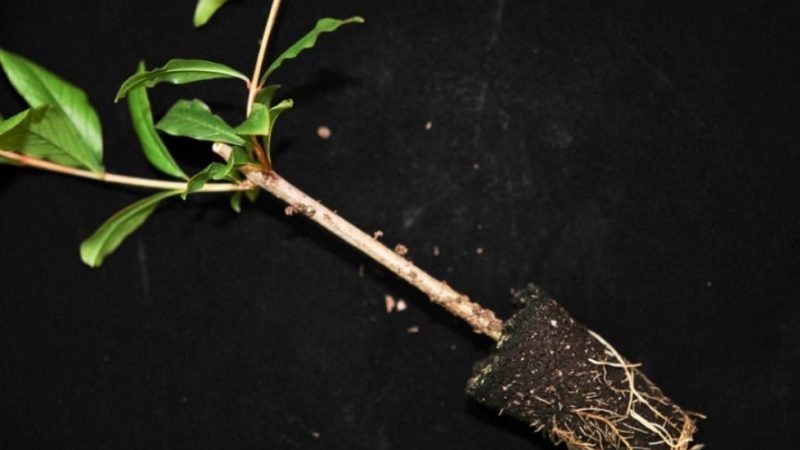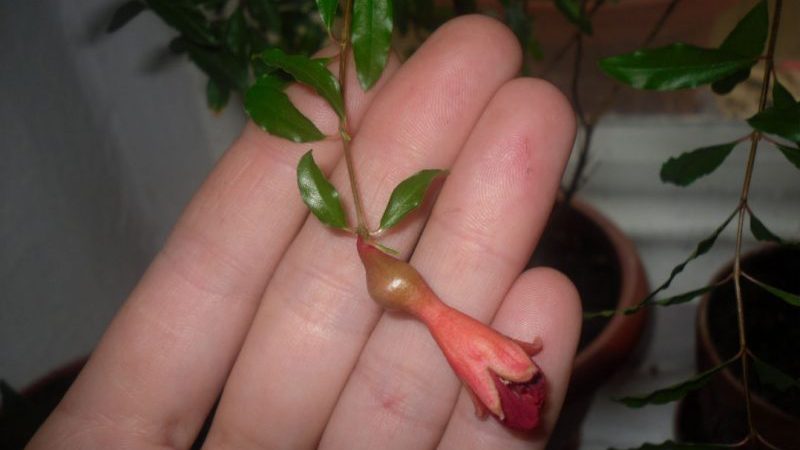Step by step guide to propagating pomegranate cuttings at home
Many people dream of decorating the landscape of their personal plot or apartment with such an exotic plant as a pomegranate. However, ignorance of the rules of growing this crop and caring for it stops. If you follow the recommendations for breeding by cuttings, it is easy to grow pomegranate trees, which will delight you not only with a fabulous aroma, but also with delicious fruits.
The content of the article
Propagation of pomegranate cuttings at home
It is not difficult to propagate home pomegranate: the plant is well formed, and the Japanese technology of pruning a miniature bonsai tree will give it the right size and beautiful shape.
 There are several ways how the culture propagates: by seeds, green shoots, lignified cuttings. The last option is the most common, simple and effective. It is based on the ability of a plant to actively regenerate, while restoring all the functions necessary for the full life of both damaged organs and individual parts. For example, over a period of time, cuttings cut from a bush develop new adventitious roots.
There are several ways how the culture propagates: by seeds, green shoots, lignified cuttings. The last option is the most common, simple and effective. It is based on the ability of a plant to actively regenerate, while restoring all the functions necessary for the full life of both damaged organs and individual parts. For example, over a period of time, cuttings cut from a bush develop new adventitious roots.
Important! The presence of strong and healthy shoots from the mother frost-resistant culture affects favorable regeneration and obtaining promising seedlings.
Advantages and disadvantages
Propagation of pomegranates by cuttings is one of the most effective ways. Lignified or green shoots serve as planting material.
The advantages of this method:
- young seedlings grown from shanks retain all the qualities inherent in the mother plant, therefore, the features of their agricultural technology and care;
- the roots are much more powerful than those of the shoots obtained by sowing seeds;
- the rooted stalk grows quickly and after 2 years it turns into a small tree;
- shanks are cut from the shoots of the last year, so they are less susceptible to diseases and wilting, in contrast to seedlings from seeds, the quality of which is unknown before germination;
- pomegranate grown from a cut is resistant to temperature changes.
This breeding method also has disadvantages:
- in the open field, cuttings take root in June - August, the roots and young growth do not have time to fully grow stronger by the onset of cold weather, which means that in winter they will need special conditions;
- the root system of seedlings is superficial, the main taproot is absent, therefore they are more demanding on soil moisture;
- it is difficult to find quality planting material.
Terms of the procedure
For cutting cuttings, the dormant time of the trees is chosen... This is early spring, when nature is just beginning to awaken from the winter cold. The tree is cut, leaving 3-5 pairs of leaves on the shoots of the current year. The cut branches remaining after the formation of the crown are placed in the water, where they start up the roots. Then they are used for breeding.
The material is planted in the ground in early May, when the ground is already warmed up enough. By next spring, the plants will actively bloom and six months later will bear the first fruits, and a full harvest - in a year.
The dormancy stage in indoor plants also ends with the onset of spring. It was during this period that cuttings are harvested so as not to harm the tree.They are placed in water with the addition of a biostimulant for rooting, and then planted in a pot.
What cuttings are suitable
High-quality pomegranate propagation material is taken from young and strong one-year-old shoots grown on adult fruit-bearing plants, and from the shoots of the root system of the culture.
Consider the following recommendations:
- The shanks are cut 20–25 cm long, leaving 4–6 buds on them.
- At the bottom, the cutting is cut under the kidney, at the top, in the middle between the kidneys.
- Cleans from lateral branches, thin, dry, upper and non-lignified ends and thorns.
- The planting material is inspected so that there are no traces of pests and diseases on it.
When using green shoots for cuttings, there is a high risk of rotting. In older branches, the formation of the root system takes much longer. Therefore, they choose those that have just begun to grow over a thin bark.
Preparing to disembark
For better rooting, preparatory measures are carried out before planting the shanks:
- 4 lower leaves are cut from the cutting.
- Cut it at an angle, retreating 2-3 mm from the eye.
- The cut is dried with a paper towel.
- 2-3 pairs of leaves are left in the upper part, the rest are removed.
- Pinch the growth point, if any.
- The stalk is left in the shade for 1–4 hours until the release of juice stops.
- The lower sections of the stems are immersed for 10-15 minutes in a root formation stimulator - an aqueous solution of "Kornevin" or "Heteroauxin" (1 g of the drug per 1 liter of water), which are suitable for rooting almost all crops propagated by cuttings.
Then 5-7 tablets of activated carbon are crushed and poured into water or mixed with soil, depending on where the cuttings will root.
Attention! Insufficient concentration of the stimulant and processing time delay root formation, and excessive concentration leads to the death of cuttings.
Preparation of containers and soil
It is preferable to use clay or ceramic pots 5–7 cm high, since the porosity of the material allows excess moisture to evaporate, and the roots to be saturated with oxygen.
Small plastic cups, best transparent to observe root formation, glass jars or cut plastic bottles are also used.
To grow pomegranates, they prepare or buy a loose, moisture- and breathable neutral mixture for indoor plants or citrus fruits.
When self-preparing the soil mixture, take a small part of the coarse-grained calcined river sand and add sod land, leaf humus and peat in equal parts.
How to root indoor pomegranate

There are many guides for rooting shanks, but when grafting, details are often found that significantly affect the result.
In water
Roots form most rapidly in water. For this:
- The collected branches are placed in 2 pieces in a half-liter container.
- Water is poured as much as needed to cover the second internode.
- Add 1 tablet of activated carbon.
- The containers are placed in a warm, light, but shaded place from direct sunlight.
The first roots will hatch in a week. If the cutting is taken from a strong and healthy tree, many strong roots will form over the next week.
Attention! It is important that the solution in the containers remains clear.
If the liquid begins to cloud, the stalk of a homemade pomegranate is taken out and treated with a slightly pink solution of potassium permanganate and the jar. Then, fresh, settled warm water is poured and the branches are placed back.
In the ground
For the formation of roots, use any containers filled with a previously prepared nutrient substrate (the composition of the mixture is indicated above).
Then they perform the following actions:
- With a pencil in the ground, make recesses at a slight angle to the south to the bottom.
- Cuttings are lowered into them so that both internodes enter the ground, and lightly rammed.
- The soil is well moisturized.
- The containers are closed with cut plastic bottles or tied with polyethylene.
- Placed on a windowsill, but not in direct sunlight.
The shelter is not removed until the roots appear (2–4 weeks). Throughout this period, greenhouses are ventilated once a day and moisten the soil.
Landing in a permanent place
As soon as 3-4 young shoots with leaves appear on the cuttings, they are planted in separate pots with a volume of no more than 0.5-0.6 liters. The plant's root system is located close to the surface, so it is undesirable to plant it in deep containers.
Selected pots with holes and a drainage layer (fine gravel or expanded clay) are filled with a nutritious soil mixture.
Next steps:
- 2 hours before transplanting, the rooted shoots are well watered.
- Then, carefully, so as not to damage the roots, they are removed along with the ground. For convenience, use a tablespoon.
- Excessively long roots hanging from a clod of earth are cut off by 1/3.
- Carefully move the sprout into a pot with prepared soil, sprinkle it with earth, compact and watered.
The containers are installed in a well-lit place. In the bright sun, they are shaded so that the sun's rays do not burn the leaves of the plants.
It is interesting:
Storage methods for grape cuttings in winter and germination in spring.
Proven ways to store grape cuttings in winter.
Step-by-step instructions for planting horseradish in the fall for novice gardeners.
Further care

Later, for 3 years in a row, the pomegranates are transplanted, gradually increasing the pot to 4 liters, then - if the tree does not have enough space.
In order not to injure the roots, the transplant is carried out by the transshipment method. Previously, the pomegranate is not watered for several days. When the soil in the pot dries up, it is turned over and the plant is removed along with a lump of earth.
How to grow indoor pomegranate from a cutting
The pomegranate tree is a tropical culture. To successfully cut it, at home it is required to create a microclimate as close as possible to the natural habitat:
- High level of illumination. For high-quality flowering and fruiting in the dark, during prolonged cloudy weather, additional lighting is used.
- High humidity. If the room is too dry, the plant is sprayed or artificially humidified. Indoor pomegranate is able to completely lose its decorative effect due to dry heated air and lack of lighting and stretch out strongly upward.
- Temperature range within + 20 ... + 25 ° C. At higher rates, the plant loses leaves, its vegetation slows down.
- Regular to moderate watering. The soil in the container should always be barely damp. During the flowering period, watering is reduced, but drying out of the soil is impermissible.
- Fertilizing the soil. Pomegranate responds well to regular feeding. For the formation of buds and abundant flowering, it requires nitrogen-phosphorus fertilizers, which are applied from March to mid-summer. In the second half of the growing season, mixtures with an increased potassium content are used.
The pomegranate grows very quickly, its thin broken twigs create a chaotic uneven crown, so the plant is pruned and shaped annually. Sometimes the procedure is carried out twice a year: before the beginning of the growing season and after the culture has faded, if there are no fruits on the branches.
Attention! The crown is formed as soon as 3-5 pairs of leaf plates grow, pinching the growth points for further branching.
Conclusion
Growing a pomegranate tree will give not only aesthetic pleasure, but also tasty, healthy fruits. When propagating by cuttings, it is important to properly prepare the shanks, containers and soil, follow the basic recommendations for caring for the plant, protect it from diseases, pest attacks and regularly take preventive measures.